AWS Identity and Access Management
- Identity and Access Management
- IAM User created through AWS CLI or AWS API
- IAM Roles
- IAM Policies
- Sample IAM Scenario: Conflicting Policies
- EC2 Instances with IAM Profile
- Cross-Account Access
- AWS Organizations
- Service Control Policies
- Policy Evaluation Logic
- Active Directory Federation within AWS
- AWS Cognito and Web Identity Federation
Identity and Access Management
IAM is used to manage access to AWS services and resources securely through users, groups, and permissions to allow and deny access to AWS resources. Important concepts to know:
-
IAM Users These are account objects that allow an individual user to access your AWS environment with a set of credentials. You can issue user accounts to anyone you want to view or administer objects and resources within your AWS environment. Permissions can be applied individually to a user, but the best practice for permission assignments is to add the user to an IAM Group.
-
IAM Groups These are objects that have permissions assigned to them via Policies allowing the members of the Group access to specific resources. Having Users assigned to these groups allows for a uniform approach to access management and control.
-
IAM Roles These are objects created within IAM which have Policy permissions associated to them. However, instead of just being associated with users as groups are, roles can be assigned to instances at the time of launch. This allows the instance to adopt the permissions given by the role without the need to have access keys stored locally on the instance.
-
IAM Policies IAM policies define permissions for an action regardless of the method that you use to perform the operation
To learn more, check out:
Best practices:
- IAM users are not equal to Root users
- Be extra cautious with root users
- Avoid using the root account in your day to day activities
- Always enable Multi-Factor Authentication (MFA)
- Never use access keys, and secret access keys with the root account
- Enable identity federation (i.e. Active Directory, Google, etc.)
- Utilize granular permissions for IAM users
- For temporary access, use AWS STS

IAM User created through AWS CLI or AWS API
By default, a brand new IAM user created using AWS CLI or AWS API has no access keys of any kind.
- no credentials of any kind
- no password and no access key (neither an access key ID nor a secret access key)
- user is not authorized to perform any AWS actions or to access any AWS resources
IAM Roles
Roles are created and assigned to AWS resources. These roles grant resources some permissions to access other AWS resources.
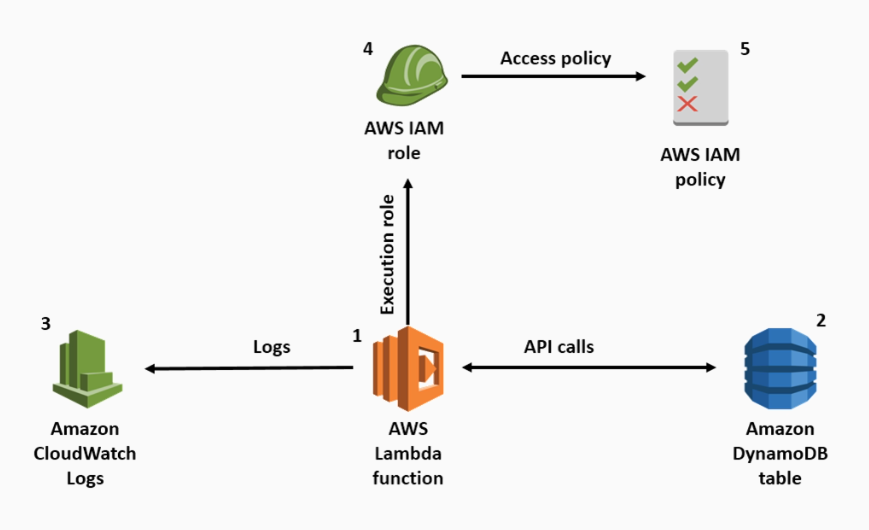
Service Roles
Allows you to apply your own customer-managed or AWS Managed policies.
- Allows AWS resources to assume a role and access other AWS resources
- can be attached to EC2 instances during creation or when it’s running
Service-linked Roles
Pre-configured with a specific set of read-only AWS-managed policies that can only be used by that particular service.
- perform functions requiring specific permissions
- roles are created during the first time you use the service
- comes with pre-built trust, permissions, and managed policies which cannot be modified
Examples of service-linked roles:
- AWS ServiceRoleForAmaazonSSM - used by AWS Systems Manager to manage resources on your behalf
- AWS ServiceRoleForCloduTrail - used by CloudTrail for managing your organizations’ trail feature
- AWS ServiceRoleForCloudWatchEvents -used by CloudWatch to perform EC2 alarm actions
Limited number of cases when Service-linked Roles can be modified
The method that you use to edit a service-linked role depends on the service. Some services might allow you to edit the permissions for a service-linked role from the service console, API, or CLI. However, after you create a service-linked role, you cannot change the name of the role because various entities might reference the role. You can edit the description of any role from the IAM console, API, or CLI.
To learn more, check out: Editing a service-linked role
IAM Policies
An IAM Policy is a document that defines one or more permissions.
-
Identity-based Policies
- Can be attached to IAM Users, User Group, or Roles
- Types:
- Inline Policies
- Attached directly with one principal entity
- not saved or stored in the policy library
- Cannot be reused
- Cannot be attached and detached
- Managed Policies
- can be attached and detached from principal identities
- these policies exist in all AWS accounts
- types:
- AWS-Managed Policies
- Standalone policy created and managed by AWS
- Hard to follow the least privilege principle
- Cannot be modified by customer
- Customer Managed Policies
- Standalone policies created and managed by customer
- enables least privilege because its customizable
- requires customer effort to create and maintain them
- AWS-Managed Policies
- Inline Policies
- Resource-based Policies
- similar to inline policies but are not attached to IAM users but instead a resource
- policies defined at the resource-level, example:
- S3 Bucket Policy
- Trust Relationship Policy
-
Permission Boundaries
- Associated with user or role but they don’t grant permission themselves
- Instead, they define the maximum level of permissions that can be granted to an identity
- policy configured for the boundary can be:
- AWS-managed policy, or
- customer-managed policy
- permission boundaries always supersede identity-based policies
-
Organization Service Control Policies (SCPs)
- used by AWS Organizations
- similar to permission boundaries, they don’t grant permissions
- they defined boundary of maximum permissions
Sample IAM Scenario: Conflicting Policies
Scenario: A user is included in multiple IAM group policies:
- One allows read-only access to Amazon EC2 with no actions denied
- Another allows full access to Amazon EC2
Solution: The IAM group policy is always aggregated. In this case, if the user does not have permission for one group, but has permission for another group, they will have full access to EC2. Unless there is specific deny policy, the user will be able to access EC2.
To learn more, check out: http://docs.aws.amazon.com/IAM/latest/UserGuide/PoliciesOverview.html
EC2 Instances with IAM Profile
We can designate an IAM role to attach to an EC2 instance when launching the instance, or any time after. Attaching an IAM role to an instance allows us to manage permissions for instances centrally with IAM.
Example screenshot below when manuelly creating EC2 instances in the AWS Management Console:
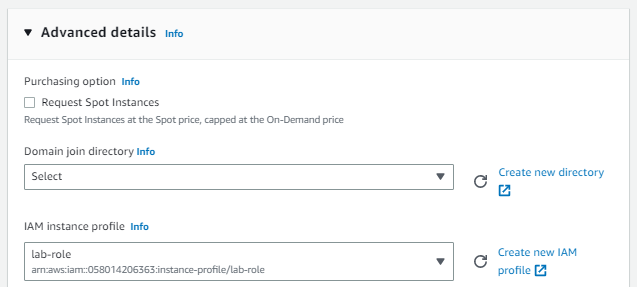
Cross-Account Access
Cross-Account Access allows you to delegate access to resources across different AWS accounts that you own without needing IAM users in each account.
- You can share resources in one account with users in a different account
- You don’t need to create individual IAM users in each account
- Users don’t have to sign out of one account and sign into another in order to access resources that are in different AWS accounts
When using a role for cross-account access, a trust policy must be established between the two accounts. This Role type offers two options:
- providing access between AWS accounts that you own
- providing access between an account that you own and a 3rd party AWS account
This access is managed by policies that establish trusting and trusted accounts that explicitly allow a trusted principal to access specific resources. Many services use Roles to allow cross-account access to resources.
To learn more, check out:
- http://docs.aws.amazon.com/IAM/latest/UserGuide/tutorial_cross-account-with-roles.html
- http://docs.aws.amazon.com/IAM/latest/UserGuide/id_roles_terms-and-concepts.html
AWS Organizations
AWS Organizations is a managed services that allows you to centrally govern you environment as you grow and scale your workloads on AWS.
- Centrally manage billing through consolidated billing
- Control access, compliance, and security
- Resources can be shared across AWS accounts
- Organize multiple AWS accounts into groups (OUs)
- Attach and detach policy-based controls (Service Control Policies)
- Govern maximum permissions granted to accounts or Organization Units (OU)
- SCPs can be viewed in the IAM menu but can only be modified through the AWS Organizations menu
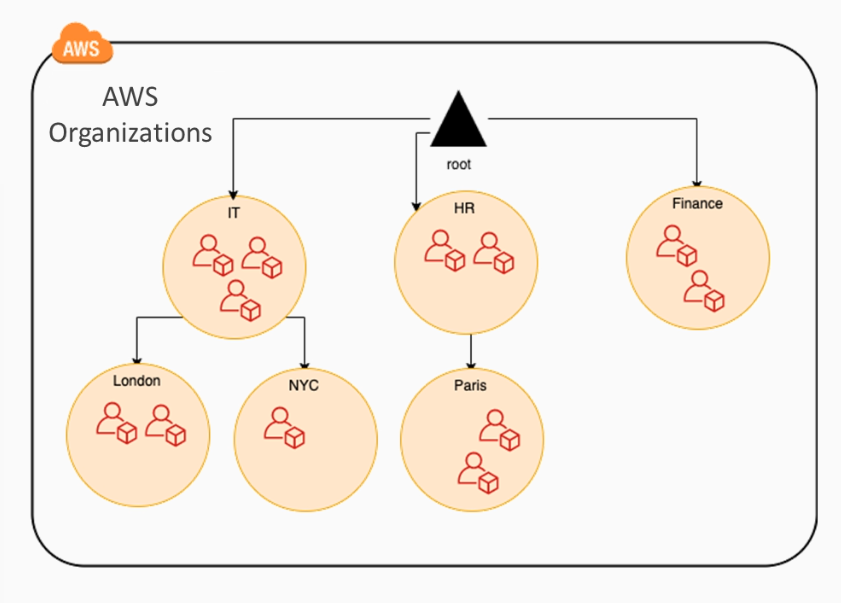
Service Control Policies
These policies enable customers to centralize how they are using AWS services across multiple accounts.
- Can be used to create permission boundaries
- Applies to OU and accounts below the specified OU
- Restrict access to AWS services
- Restrict what IAM (or even root) users have access to
- SCPs can only deny and not allow
Policy Evaluation Logic
Process:
- User sending the request has to be authenticated as a valid user.
- AWS checks the context of the request (e.g. what service, what actions).
- AWS performs polcy evaluation to determine the level of access.
- AWS provides a result based on the evaluated policies, whether allowed or denied.
Policy Evaluation:
- All access are DENIED by default.
- Principal is checked if it has ALLOW access.
- If a DENY access for the resources is defined, it will override ALLOW access on the resource.
Evaluation order of Policies:
- Organizational SCPs
- Resource-based Policies
- IAM Permission Boundaries
- Identity-based Policies
For more details, check out Policy evaluation logic.

Active Directory Federation within AWS
AWS allows federation with your existing Active Directory by enabling your corporate credentials as your AWS sign-in.
- Minimal operational overhead by using existing accounts, groups, and policies
- Single sign-on
- Managing users can be done on the AD-level
- Seamless sign-in from the user’s perspective
- Users can assume roles based on their AD group membership
ADFS Active Directory Federation Service or ADFS provides the SSO and identity broker in Active Directory.
SAML 2.0 Open standard that enables the exchange of identity information between providers and applications. This also enables the SSO in AWS accounts.
Two-way trust
- For the integration to work, it needs a two-way trust
- ADFS needs to be a trusted ID provider in AWS
- AWS is a trusted relying party in AWS
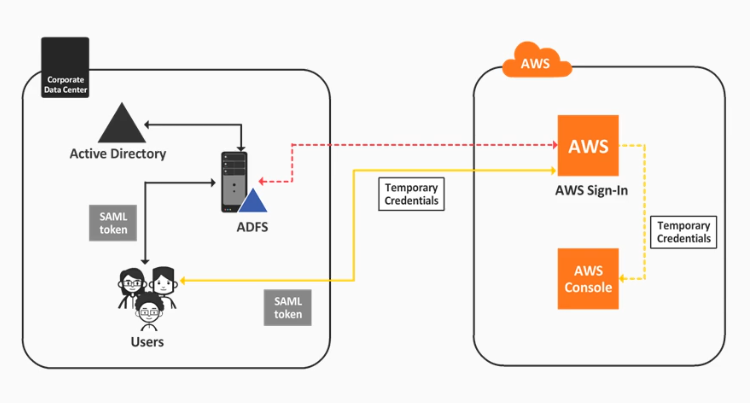
How it works:
- User authenticates with ADFS/AD and receives a SAML token
- The token is exchanged for an AWS temporary credentials in the AWS sign-in endpoint
- This exchange is done via STSAssumeRoleWithSAML service
- User is redirected to the AWS console
- User will only be able to access resources that their role allow
- Accounts are not replicated in AWS, they only reside in Active Directory
AWS Cognito and Web Identity Federation
Amazon Cognito lets you add user sign-up, sign-in, and access control to your web and mobile apps quickly and easily.
- scales to millions of users
- supports sign-in with social identity providers, such as Facebook, Google, and Amazon, and enterprise identity providers via SAML 2.0
Cognito User Pool Manages user sign-in and sign-out directly or via web identity providers (same as identity broker)
Cognito Identity Pool Enables identity creation for users and authentication with providers
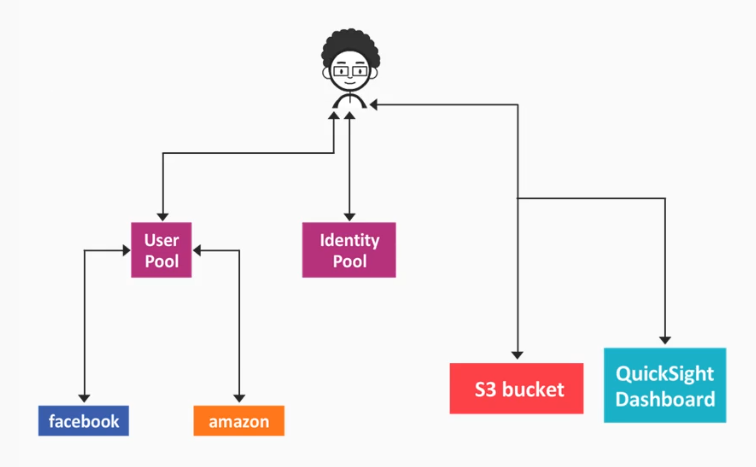
How it works:
- Users sign-in directly to a user pool or indirectly via an identity broker (e.g. Amazon or Facebook)
- If authentication is successful, it will generate a JWT (JSON Web Token)
- The JWT can be used to get temporary AWS credentials with permissions to AWS resources